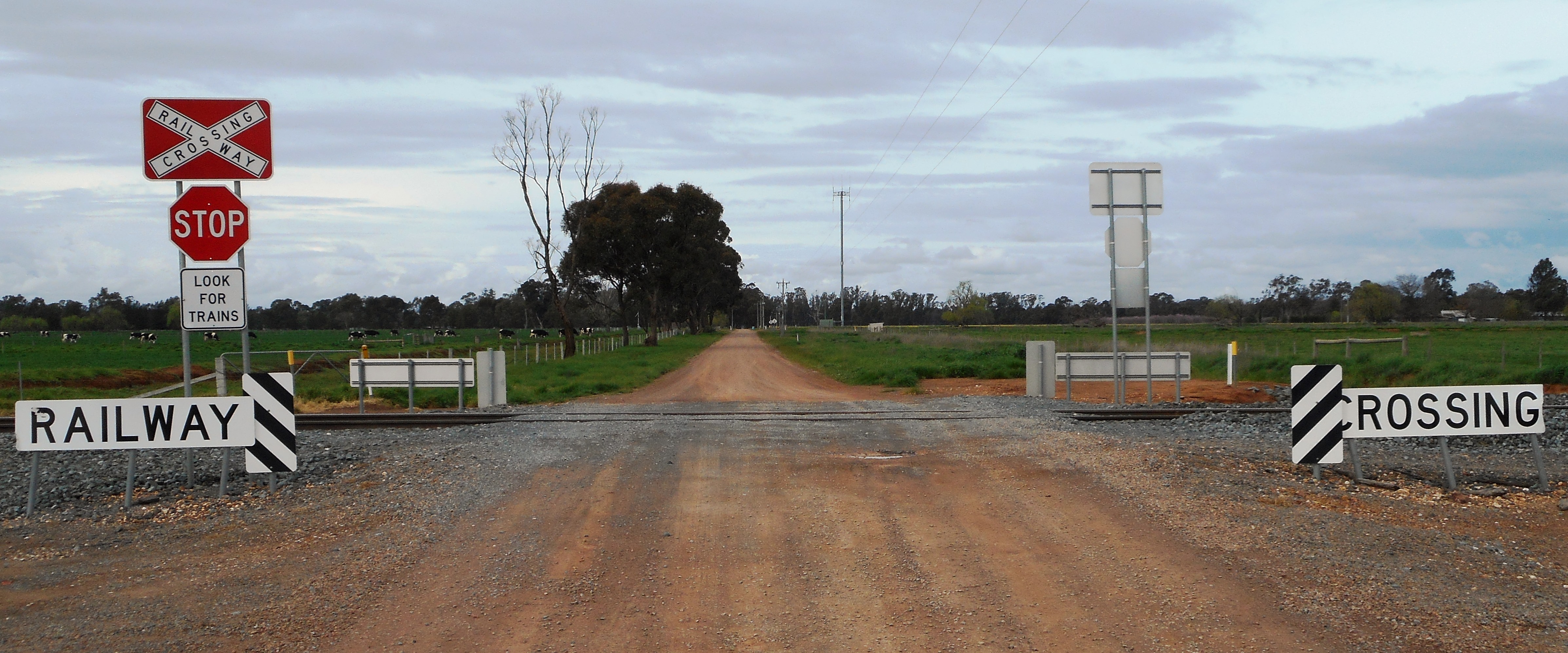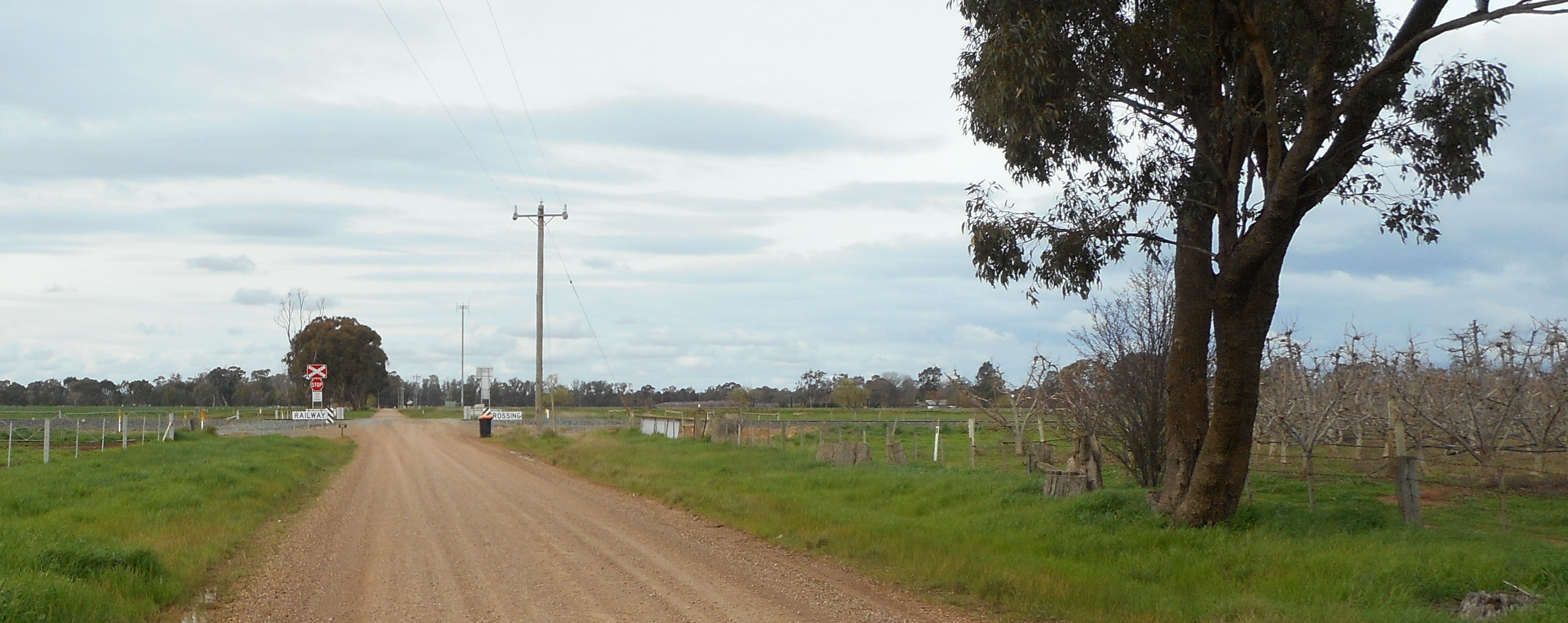What happened
On the morning of 27 July 2016, V/Line passenger train 8309 departed Melbourne for Shepparton, Victoria. The train consisted of a locomotive hauling four passenger cars and was crewed by a driver and conductor. There were 22 passengers on board when the train approached the regional town of Toolamba, south of Shepparton.
At about 1147 the train had passed Toolamba, and approached the Pogue Road level crossing travelling north at about 100 km/h. At about the same time, a utility vehicle was travelling east along Pogue Road and was approaching the level crossing. The crossing was controlled by a Stop sign (Figure 1) that required road users to stop near the crossing and look for trains.
Figure 1: Pogue Road level crossing viewed from the direction of the car’s approach

Source: Chief Investigator, Transport Safety (Vic)
The driver of the car travelled this route almost daily and was familiar with the crossing. On this day, he had driven into town earlier that morning and was returning home. On the approach to the crossing, the driver’s view towards the train was obscured by an orchard and road side trees to the south-west of the crossing (Figure 2).
Figure 2: Pogue Road approach to the level crossing. The view to a train approaching from the right was obscured by road-side vegetation and an orchard.

Source: Chief Investigator, Transport Safety (Vic)
When the train came into view, the driver applied the vehicle’s brakes, leaving skid marks on the gravel road about 40 m in length. However, the vehicle could not be stopped before the crossing and collided with the first passenger carriage behind the locomotive. The impact was to the underframe area of the carriage and dislodged a diesel fuel tank from the train. The passenger compartment remained intact and there were no reported passenger injuries. The road vehicle was severely damaged (Figure 3) and its driver suffered bruising injuries.
Figure 3: Damaged road vehicle and the fuel tank from the impacted rail car.

Source: V/Line Pty Ltd
The train driver had sounded the train horn as the train approached the whistle board that was located 400 m from the crossing, and again a short distance before the crossing. He reported that he did not see the road vehicle. The impact of the car on the train alerted the driver to the collision and he made an emergency brake application.
ATSB comment
Road vehicle driver
The driver was very familiar with the crossing and had used it many times without seeing a train, probably reducing his expectation. This factor and possibly other distractions led to the driver approaching the crossing with a reduced level of vigilance.
Level crossing
Pogue Road is a single-lane gravel road with a speed limit of 100 km/h. It intersected the 100 km/h train line to Shepparton at near right angles. The crossing was controlled by Stop signs (passive control) that required road users to come to a stop and check for trains before proceeding. The signage at the crossing and the advanced warning signage on the approach was in good condition and generally consistent with the Australian Standard for railway crossing signage[1], with minor variations not material to this incident. There have been no previous near-miss or collision incidents reported at this level crossing.
The road-side vegetation and orchard meant that the view to the track was obscured on the approach to the crossing. The provision of Stop sign traffic control measures is consistent with this configuration, as this required road users to stop in a position that would allow them to sight trains.
Passive control measures at level crossings
A range of studies have found that providing active warnings reduces crash rates by 48 to 88 per cent[2]. The same paper recommends further research into low-cost warning devices for passive crossings[3]. On passenger lines, the risk associated with collision extends to rail passengers.
Safety message
Road users are reminded to be vigilant when approaching a passive rail level crossing and check for trains in both directions before crossing.
Rail operators should continue to consider options for reducing the risk of collision at crossings with passive (only) control devices, particularly on passenger line corridors.
Purpose of safety investigationsThe objective of a safety investigation is to enhance transport safety. This is done through:
It is not a function of the ATSB to apportion blame or provide a means for determining liability. At the same time, an investigation report must include factual material of sufficient weight to support the analysis and findings. At all times the ATSB endeavours to balance the use of material that could imply adverse comment with the need to properly explain what happened, and why, in a fair and unbiased manner. The ATSB does not investigate for the purpose of taking administrative, regulatory or criminal action. TerminologyAn explanation of terminology used in ATSB investigation reports is available here. This includes terms such as occurrence, contributing factor, other factor that increased risk, and safety issue. Publishing informationReleased in accordance with section 25 of the Transport Safety Investigation Act 2003 Published by: Australian Transport Safety Bureau © Commonwealth of Australia 2016
Ownership of intellectual property rights in this publication Unless otherwise noted, copyright (and any other intellectual property rights, if any) in this report publication is owned by the Commonwealth of Australia. Creative Commons licence With the exception of the Coat of Arms, ATSB logo, and photos and graphics in which a third party holds copyright, this publication is licensed under a Creative Commons Attribution 3.0 Australia licence. Creative Commons Attribution 3.0 Australia Licence is a standard form licence agreement that allows you to copy, distribute, transmit and adapt this publication provided that you attribute the work. The ATSB’s preference is that you attribute this publication (and any material sourced from it) using the following wording: Source: Australian Transport Safety Bureau Copyright in material obtained from other agencies, private individuals or organisations, belongs to those agencies, individuals or organisations. Where you wish to use their material, you will need to contact them directly. |
__________


